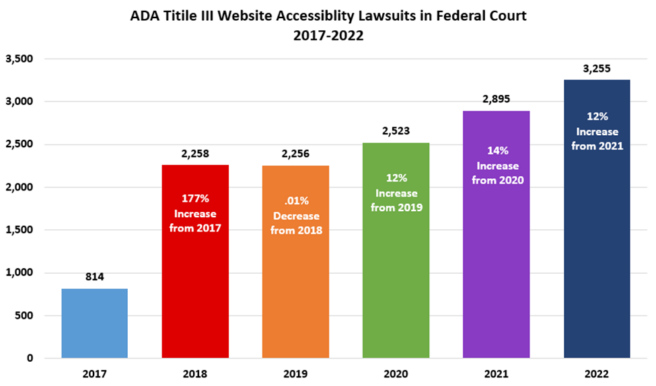Despite the wealth of information available, many businesses still struggle with accessibility. Generally, web designers often don’t even have a basic understanding of what's required to meet digital accessibility requirements, so there’s a lot of inaccessible websites on the internet. Those businesses are leaving themselves open to the business risks of not only losing sales, but also having legal cases brought against them.
It’s essential today for all businesses, marketers and web designers to have a basic understanding of digital accessibility. But it's also true that the accessibility rules can be confusing. The WCAG Guidelines and Standards may make your head spin, but it’s a legal requirement in the USA for any organization with a public facing website or mobile app to meet those standards, so you can’t afford to ignore them.
Besides, an inaccessible website impacts more than only those people with vision impairments.
The World Health Organization (WHO) estimates that by 2030, 1 in 6 people in the world will be aged 60 years or over, and by 2050 they’ll total 2.1 billion. That statistic alone means inclusive technology needs to be used to overcome poor accessibility for those with physical and cognitive disabilities, as well as the growing number of aging people with diminishing vision.
Inaccessible websites typically have poor color contrast, difficult to read fonts for headings and text, limited to no auto-translation, poor SEO, aren’t able to be used with the many digital assistive technologies (screen readers, text to speech readers, screen magnifiers, voice recognition, keyboard-only navigation, braille keyboards, or alternative input devices) and they're generally devoid of browser zoom.
Fixing these issues not only overcomes poor accessibility, it also enhances the user experience (UX) for all people accessing the site – no matter their age or ability.
What is web accessibility?
Web accessibility is the degree to which people with some form of disability (physical or cognitive) can access, browse, and use a website. It takes into account people’s differing abilities to see, hear, touch, move, understand, and communicate, and provides alternative ways for people to consume digital content, as well as easily navigate the website.
For example, people with vision impairments may need to use screen readers to navigate and/or read a website or page, while those who are deaf need transcripts and captions on the site, to be able to experience video and audio content.
Following web accessibility best practices such as the World Wide Web Consortium, or W3C Guidelines ensures that people of all abilities can access your content in their own way. But unfortunately, most websites aren’t designed or developed with accessibility in mind.
The business risks of bad accessibility
Accessibility matters for all businesses, not just large corporations. Ignoring the fact you have an inaccessible website, can create three key business risks:
1. Site abandonment
The numbers don’t lie. By impeding people from having free access to your online content, product offerings and services, it’s losing you money. Especially when you appreciate that approximately 16% of the world’s population experience some type of disability.
The English company Click-Away Pound surveyed ecommerce site users in 2016 and 2019, and found that 69% of respondents abandon websites due to a lack of accessibility.
|
Click-Away Pound Survey – Comparison of Key Findings 2016 to 2019 |
||
|
Finding |
2016 |
2019 |
|
Number of disabled people online with access needs |
6.10M |
7.15M |
|
Percentage of disabled people with access needs who say they ‘click away’ from a site with barriers |
71% |
69% |
|
Value of the ‘click away’ spend which went to more barrier-free sites |
£11.75b |
£17.1b |
|
Percentage of users with access needs who feel accessibility is more important when making spending decisions than price |
81% |
75% |
|
Percentage of users with access needs who would spend more if there were fewer barriers |
82% |
86% |
|
Percentage of users with access needs who limit their shopping to sites they know are barrier-free |
85% |
83% |
|
Percentage of users with access needs who contacted the site owner about barriers they experience |
7% |
8% |
Source: 2016-2019 Comparison Results
If someone can’t use your website because it has poor accessibility, they’ll abandon it, navigate back to Google and use a competitor’s site that isn’t inaccessible.
2. Loss of potential customers
As well as an aging population, WHO estimates that at least 2.2 billion people live with vision impairments – totalling about 30% of the world’s population. Having an inaccessible website means you’re ignoring a sizable percentage of potential customers, who’s spending power and word-of-mouth (WOM) recommendations could have a significant, positive impact on your business.
How many potential customers are you turning away because they can’t interact with your website or app? And how much revenue is it costing you?
In a 2019 study, Nucleus Research found that more than 70% of websites have “critical accessibility blockers” that render them unusable by many people with disabilities. At the time, it estimated that U.S. e-commerce retailers could have been losing up to $6.9 billion annually to competitors with more accessible websites.
An accessible website opens the door to millions of new customers – who currently cannot interact with your business due to digital barriers in communication.
3. Lawsuits
While many people just click away from an inaccessible website, since the introduction of Section 508 of the Rehabilitation Act and Title III of the Americans with Disabilities Act (ADA), more and more people are challenging their inability to access websites through the courts. Generally speaking, it's a legal requirement for many American businesses to ensure individuals have equal access to information and other important areas of life via the internet, and if your business isn’t currently covered by the legislation, that’s likely to change shortly. Similar legislation has followed in numerous countries and regions across the world, so the onus is on every business owner to ensure they don't have an inaccessible website.
In 2022, the number of web accessibility lawsuits citing Title III of the Americans with Disabilities Act (ADA) legal filings reached a new record, with plaintiffs filing 3,255 lawsuits, which was a 12% increase from 2021.

Historically, there’s been an increasing number of lawsuits – especially in the United States – against big name brands, with the funds available for big payout to the plaintiffs. To date, businesses have been predominantly targeted, although the suits span a large range of industries. Some recognizable brands that have faced accessibility lawsuits include:
- Domino's
- Harvard
- Hulu
- H&R Block
- Winn-Dixie
- Bag’n Baggage
- Netflix
Sources: LA Times, Essential Accessibility, 3Play Media
Businesses and brands who fail to make their inaccessible website accessible, are now vulnerable to discrimination lawsuits, stiff penalties and hefty legal fees.
4 steps to convert an inaccessible website to compliant
With accessibility a serious business risk, it’s important to take active steps to avoid financial loss, degradation of your brand image and legal action. To avoid those risks:
- Prioritize accessibility on your web development roadmap
- Don’t trust free accessibility checking solutions
- Regularly monitor your content’s compliance
- Go beyond the WCAG standard A compliance level (AA or AAA)
There’s also accessibility tools and plugins you can use to help you create, check and publish compliant content.
Your HTML editor can resolve many accessibility issues
It’s not widely known that the rich text editor within your software can play an active role in avoiding accessibility issues. In the case of an inaccessible website, if the content management system (CMS) uses TinyMCE as its default HTML editor, you can add additional accessibility functionality, so your content creators can check, flag and fix before anything’s published.
The TinyMCE Accessibility Checker (Premium) plugin is set at compliance level AA, of the WCAG Guidelines. Once you’ve typed or pasted the content into the editor UI, click a button and it works in the background to review your content. If it detects any accessibility issues, it flags any that may be a potential problem for someone with a disability, and suggests how you can resolve the issues that it finds.
For more on Accessibility, read the TinyMCE guide on accessibility and emoji, as well as the guide on how accessible product design helps everyone and learn from our infographic on How to write alt text for images.
Contact us today if you have any questions about how TinyMCE’s Accessibility Checker (Premium plugin) can support you.
